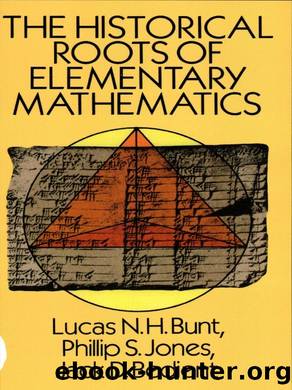The Historical Roots of Elementary Mathematics by Lucas N. H. Bunt & Phillip S. Jones & Jack D. Bedient

Author:Lucas N. H. Bunt & Phillip S. Jones & Jack D. Bedient
Language: eng
Format: epub
ISBN: 9780486139685
Publisher: Dover Publications
Published: 2012-10-11T16:00:00+00:00
Figure 6-2
Then X is the required point.
Proof (ââ´â is an abbreviated way to write âhenceâ or âtherefore.â)
We further have
and hence
Remarks
1. See steps 4 and 6. Just as with Proposition 1 we notice here a gap in the method of proof. By what right does Euclid assume that (in 4) circle (A, ) intersects extended and (in 6) that circle (C, ) intersects extended? Euclid here makes use of the fact that a ray which has the center of a circle as its endpoint has a point in common with the circle. However, he gives no proof of the existence of such a point. He could not have done so anyway without adding appropriate postulates. He therefore concludes on intuitive grounds that the existence of a point of intersection has been established.
2. Postulate III says that with any point as center and any radius, a circle can be drawn. Could Euclid then not have proved Proposition 2 simply by saying: Draw a circle with center P and radius ? He does not do this. Apparently, he does not want Postulate III to be understood in such a way, that it is possible to draw a circle with center P and a line segment congruent to (P â A A, P â B) as a radius. But he does draw several circles with a given center and a radius that is a line segment with the given center as one of its endpoints. Thus, it appears to be his intention that circles can only be drawn in this way. Hence, Postulate III should be read as follows: To draw a circle with any point P as its center and any line segment as a radius. That is, the given radius must be a line segment with the given center as one of its endpoints.
3. The preceding remark can be illustrated by imagining an instrument that will allow us to draw only those circles which can be constructed as a consequence of Postulate III. Such an instrument is a compass having the property of collapsing as soon as either leg is lifted from the paper. With such a compass we can draw circle (P, ) but not circle (P, ), for when we would try to move to P, the compass would collapse.
4. Proposition 2 shows that it is possible to âmoveâ any line segment in such a way that one of its endpoints coincides with P. From this it follows that it is also possible to draw immediately a circle with center P and radius . Hence, after Proposition 2 has been proved, the âcollapsible compassâ and the (rigid) compass are completely equivalent in their use.
In Exercises 2 through 8 of Exercises 6-6 the reader will be asked to carry out a series of constructions with the collapsible compass, which will result in a construction that can be used to give another proof of Proposition 2.
Download
This site does not store any files on its server. We only index and link to content provided by other sites. Please contact the content providers to delete copyright contents if any and email us, we'll remove relevant links or contents immediately.
Invention by James Dyson(725)
Thinking Better by Marcus du Sautoy(681)
The Ten Equations That Rule the World by David Sumpter(674)
Concepts of Space by Jammer Max;(656)
God and the Multiverse by Victor J. Stenger(632)
Wanting by Luke Burgis(627)
Merchants of Doubt by Erik M. Conway(625)
How We Got to Now by Steven Johnson(602)
Factfulness by unknow(562)
The Surrender Experiment by Michael A. Singer(539)
The Smallest Lights in the Universe by Sara Seager(514)
On Creativity by Bohm David(490)
Floods, Famines, and Emperors: El Nino and the Fate of Civilizations by Brian Fagan(482)
Ancient Knowledge Networks by Eleanor Robson;(480)
Why Birds Matter by University of Chicago Press(471)
The Scientist and the Psychic by Christian Smith(463)
The Science of Being Lucky: How to Engineer Good Fortune, Consistently Catch Lucky Breaks, and Live a Charmed Life by Peter Hollins(462)
The Oxford Handbook of Philosophy of Mathematics and Logic by Stewart Shapiro(453)
Flood by Design (Design Series) by Mike Oard(428)
